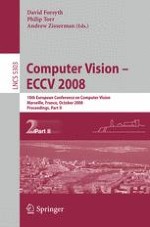The four-volume set comprising LNCS volumes 5302/5303/5304/5305 constitutes the refereed proceedings of the 10th European Conference on Computer Vision, ECCV 2008, held in Marseille, France, in October 2008. The 243 revised papers presented were carefully reviewed and selected from a total of 871 papers submitted. The four books cover the entire range of current issues in computer vision. The papers are organized in topical sections on recognition, stereo, people and face recognition, object tracking, matching, learning and features, MRFs, segmentation, computational photography and active reconstruction.
